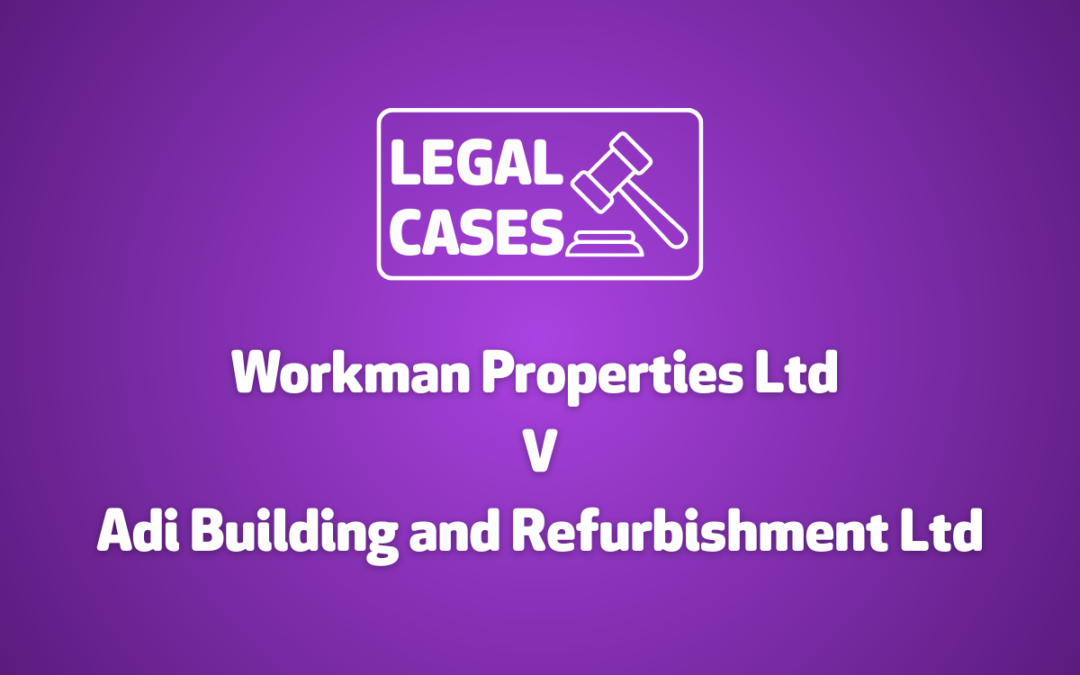
by Clair Mooney | 29 May, 2025 | Building Safety Act, Contractual and Legal, Legal cases, Main News Feed
On 21 May 2025 the Supreme Court handed down Judgment in the case of URS Corporation Ltd -v- BDW Trading Ltd [2025] UKSC 21.
This Judgment is perhaps one of the most significant since the Building Safety Act came into force as it starts to give us an indication of how Developers claims are going to impact the wider market. The case addressed important issues such as:
(1) the scope of duty and the recoverability of loss in negligence;
(2) limitation periods under section 135 of the Building Safety Act 2022 (BSA);
(3) whether section 1(1)(a) of the Defective Premises Act (DPA) applies to developers; and
(4) whether a judgment or settlement is required to enable a party to bring a contribution claim under the Civil Liability (Contribution) Act 1978 (Contribution Act).
The facts
BDW is a major property developer and includes Barratt Homes and David Wilson Homes. URS, was engaged by BDW to act as a structural design consultant in connection with multiple high-rise residential developments which completed some considerable time ago. In the aftermath of the Grenfell Tower tragedy BDW reviewed its portfolio. Two of its high-rise residential developments contained design defects.
Even though BDW had disposed of its interest and sold the developments, in 2020 and 2021 BDW undertook remedial works to the properties at significant cost. At this stage no claim was made against BDW by any third party and in any event, at the time, any such claims would have been time barred.
In March 2020, BDW brought a defects claim against URS to recover its losses. BDW successfully amended the claim in June 2022 following the coming into force of the BSA which retrospectively extended the limitation period for claims under section 1 of the DPA from 6 to 30 years. The case ended up the Supreme Court where Seven Justices of the Supreme Court heard 4 grounds of appeal in December 2024:
Decision
All four grounds the Court found in favour of BDW (URS’s appeals were dismissed):
| Ground 1 |
Is loss that is otherwise recoverable in the tort of negligence irrecoverable if it is incurred (i) without an enforceable legal obligation to do so, and (ii) in respect of property in which the claimant has no proprietary interest, because such loss is voluntarily incurred, and that means it falls outside the scope of the defendant’s duty of care and/or is too remote?
No. There is no rule of law which means that the voluntary carrying out of the repairs by BDW render the repair costs (1) outside the scope of the duty of care owed or (2) too remote. Whether these costs were recoverable is a question of fact and depends on legal issues of causation and mitigation which will be assessed when considering liability. The effect of this is that developers who incur costs to remedy building safety defects, even in the absence of a claim from a third party, may be able to recover these costs from the negligent builder or designer.
|
| Ground 2 |
Does section 135 of the BSA (extended limitation period) apply in the present circumstances and, if so, what is its effect?
Yes. Section 135(3) BSA applies to claims which are dependent on s.1 DPA. To make a claim, a developer would need to establish that it applies to actions arising out of a liability that is dependent on section 1 of the DPA even though it is not an action brought under section 1 of the DPA. Such actions are clearly “in respect of damage or defects in relation to buildings”. The Supreme Court said the alternative would undermine the purpose of the BSA i.e. to ensure those responsible for historic building safety defects are held to account.
There is a possible sting in the tail for developers or other relevant claimants seeking to recover losses incurred despite the existence of a potential limitation defence. This is because section 135 (3) BSA does not retrospectively affect the answer to the questions of causation, mitigation and remoteness which determine whether a developer can recover compensation from a negligent designer or contractor for the cost of remedial work carried out before June 2022. This will be a matter to be addressed when considering liability.
|
| Ground 3 |
Does section 1(1)(a) of the DPA also apply to property developers?
Yes. The Supreme Court have said that there is no reason why a developer cannot both owe a duty and be a owed a duty, particularly where the developer is the first owner.
|
| Ground 4 |
Is BDW entitled to bring a contribution claim against the URS under section 1 of the Contribution Act when there has been no judgment or settlement between BDW and any third party and no third party has ever asserted any claim against BDW?
Yes. The Supreme Court held that the right to contribution arises when: (i) damage has been suffered by C for which D1 and D2 are each liable; and (ii) D1 has paid or been ordered or agreed to pay compensation for the damage to C. On the facts, BDW paid compensation (in kind) for the damage suffered by the homeowners by carrying out the repairs. The fact that there has been no judgment against the developer or admission of liability or settlement between it and any of the homeowners, nor any claim, does not prevent the claim for contribution.
|
It is worth noting too that, as intervener, the government made written submissions relating to the background to the BSA, the structure of the BSA and the policy and purpose underlying the BSA in general and section 135 in particular. These submissions were very much supportive of BDW’s case.
The consequences
The Supreme Court has provided encouragement and motivation to developers to be proactive in carrying out repairs by clarifying the law and signifying that there are a host of options available to them to seek to recover those costs.
This gives “teeth” to the BSA and the policy underpinning the Act.
The Supreme Court’s decision will likely have a significant impact on historic claims for building safety defects. However, there are some wrinkles to be ironed out. Whilst the policy behind the decision may be clear, some of the legal issues remain complex and nuanced and the effect of this judgment will be subject to further debate and discussion and clarification by the court and for future cases to involve arguments around causation and mitigation.
This article is an abridged version of an article originally written by FIS Legal Advisors Hill Dickinson, the full article can be seen here.

by Clair Mooney | 2 Apr, 2025 | Contractual and Legal, Legal cases
The case of
Workman Properties Ltd v Adi Building and Refurbishment Ltd involved the
expansion of existing facilities at Cotteswold Dairy in Gloucestershire. The dispute centred on the design responsibilities under an amended JCT Design and Build Contract 2016, specifically regarding the completion of the design to RIBA Stage 4 and/or BSRIA Stage 4. This case sheds light on several important legal principles and underpins concerns raised by FIS regarding the impact on the levels of design completeness and greater risk being pushed into the finishes and interiors sector in the face of increased building complexity and concerns related to compliance and insurability in the architectural world. The key points of the case were:
- Design Responsibility
- The court clarified that the contractor, ADI, was responsible for completing the design to RIBA Stage 4/BSRIA Stage 4 (i). This decision rejected ADI’s argument that Workman Properties had warranted the design’s completeness.
- The judgment emphasized the importance of clear contractual terms in defining design responsibilities. It highlighted that the contractor must ensure compliance with the employer’s requirements, even if the design is incomplete at the time of contract formation.
- Contractual Interpretation
- The court underscored the principle that contracts should be interpreted based on their written terms rather than subjective intentions or pre-contractual negotiations.
- ADI’s reliance on pre-contractual exchanges and subjective understandings was deemed irrelevant and inadmissible. This reinforces the importance of relying on the contract documents themselves for interpretation.
- Suitability of Part 8 Procedure
- In another concerning aspect of the judgement, the court found that the adjudicators decisions were based on an incorrect interpretation of the contract. ADI had previously succeeded in adjudications related to design obligations and financial claims.
- The court emphasized that the Civil Procedure Rules Part was appropriate for resolving the dispute, as the issues were primarily legal and did not involve substantial factual disputes. In this the court rejected ADI’s contention regarding the relevance of pre-contractual negotiations and subjective understandings (the facts of the case).
- In doing this the court’s decision clarified the contractual position regarding design responsibility, providing a foundation for resolving future disputes efficiently (setting precedence).
This case serves as a reminder of checking the design and pricing risk when confronted with an incomplete design, the importance of precise drafting in construction contracts and the limitations of relying on external factors and secondary communications for adapting the principles set down in the contract.

by Iain McIlwee | 11 Jan, 2023 | Legal cases, Transformation
The case of LDC (PORTFOLIO ONE) LIMITED vs (1) GEORGE DOWNING CONSTRUCTION LIMITED (GDC) EUROPEAN SHEETING LIMITED (ESL). Starts to give fresh insights into how claims will be heard in the new compliance landscape.
The case related to external wall works carried out by ESL under a sub contract to GMD Developments Ltd (the main contractor). Both contractors were retained on a design and build basis and both issued collateral Deeds of Warranty dated 17 October 2008 in favour of the then employer, GMD. Those Deeds of Warranty were subsequently assigned by GMD to LDC (the employer).
The works related to three blocks, each over 18m high, and each with a different configuration of external wall cladding. In each case, on the inside of the external wall cladding there is a breather membrane and Structural Insulated Panels (“SIPs”). The SIPs were fixed to the structural concrete frame of each block. The case is built on the fact that that following water ingress issues and subsequent investigations into the as-built Property, it was discovered that:
- There are several defects in the external wall construction of the composite cladding elevations which have led to water ingress and deterioration of the SIPs.
- There are fire barrier and fire stopping issues on all elevations; including in relation to the cavity barrier provision between the outer face of the SIPs and the rear face of the cladding panels on the Cor-ten elevations, and between the rear of the SIPs and the concrete slab and between SIPs, on all elevations.
Other material factors were that GMD had already agreed to a settlement of £17,650,000 with LDC, so the judgement being sought was related to LDC’s claim against ESL in the sum of £21,152,198.87 calculated as follows:
- Cost of remedial works: £16,457,825.87; and
- Loss of Income: £4,694,373.00; and
- Downing’s claim for an indemnity and/or contribution against ESL in the sum of£17,650,000 together with Downing’s reasonable costs of defending the claim brought against it by LDC
The Judge found in favour of the Claimant and ESL were required to meet the full costs. The case raises a number of issues.
The first is that it was heard despite the fact ESL are currently in Liquidation. This means that any liability is likely to be met via a Professional Indemnity claim against the collateral warranty. What is not clear is whether cover is commensurate with the claim or whether any subsequent claim could be brought against duty holders associated with ESL to meet any shortfall. The judgement itself is silent on this, but new legal precedence has been created by the Building Liability Order is yet to be tested. On this aspect, this may not be the last we hear from this case.
The second is that it was 15 years ago – remember the Defective Premises Act now allows retrospective claims to go back 30 years (reverting to 15 years on jobs that started after the Building Safety Act was introduced in 2022).
Another important point is that the case rests not on whether the cladding needed to be removed due to the original selection of the SIPS system (it was replaced with SFS), but to address moisture ingress creating structural issues and uncovering fire safety concerns during investigation. Consequently this judgment makes no reference to initial manufacturer claims. Worth dwelling on is that whilst, for the purposes of remediation a new cladding system was selected and the judgment made reference to “post-Grenfell enhanced Regulation”, the premise of the case is that the works themselves fell short of the requirements due to moisture ingress creating structural concerns and residual fire safety concerns related to changes to the specification during the construction process. In her findings the Judge, Ms Buehrlen KV, concurred that it was more cost effective to replace the entire system and SFS was a better alternative in the wake of new guidance. The comments from Technical Witness Mr Fung are interesting in the reference whether the need to replace was proportionate, but the defence seemed to rest on the fact that any remedial encapsulation would not represent a tested solution. The whole case doesn’t really get into the original specification and whether the potential would be a need to replace regardless due to new cladding legislation. It is what we don’t know here that stands out here.
Another and perhaps the most significant aspect of the case is that a design change was pivotal to the judgement and attempts to caveat changes by ESL were not accepted. This judgement centred on design detailing (i.e. missing verticle fire breaks and EPSM Membrane based on the original Architectural Specification) and workmanship (i.e. missing fixings and issues with the horizontal fire breaks) associated with the original cladding specification. Failings and subsequent damage caused by water ingress to the original cladding system meant it was deemed to be structurally unsound and there were concerns about the fire safety raised.
ESL claim that they were instructed to omit the vertical cavity barriers and EPDM included in the Architectural Specification. We are not party to where, how and why the decision was made around removing fire breaks, but ESL did as a result of the claim that they were “instructed to omit” attempt to exclude the provision of fire breaks from their contractual responsibility. The judgement refers to emails and ESL in their original defence maintained that they were not responsible for the design of cavity barriers and they were instructed to omit the EPDM which caused or contributed to the water ingress issues. Much we don’t know, but if there was pressure put on them to value engineer, a buildability issue was uncovered or whether any external advice was provided, it was not recorded and presented in a manner that convinced the judge that ESL were not ultimately responsible. The Judge determined that these elements were intrinsic to the “design of the cladding and rainscreen” to deliver compliance and so regardless of the attempt to exclude and ESL was left with the liability. The balance between these elements and workmanship issues was not discussed.
In conclusion the judge references the details from the Mulalley case in so far as “Building Regulation Compliance” falls under “Reasonable Skill and Care” in design and meetiing “All Statutory Requirements” in the case of the D&B Sub Contract. The judge determined that the attempts to caveat elements of the design doesn’t supersede a contractual obligation to meet “All Statutory Requirements”. It is unclear to me in the judgement how or why these decisions were reached.
Whilst the full implications of this judgement are yet to be determined, it does throw up some concerns for sub-contractors both in terms of the potential for legacy claims, underpins the need to ensure any change to the specification is appropriately signed off and to exercise caution in terms of the assumption that an express caveat releases a party from their core contractual requirements.
This article was prepared by Iain McIlwee and provided in good faith based on initial reading, FIS Lawyers will be looking in more detail at the full implications of this case and potential precedent set.
This judgement has not, at the time of writing been uploaded to the BAILII website, but will appear here imminently, if you are interested to read the full transcript in the interim email iainmcilwee@thefis.org



